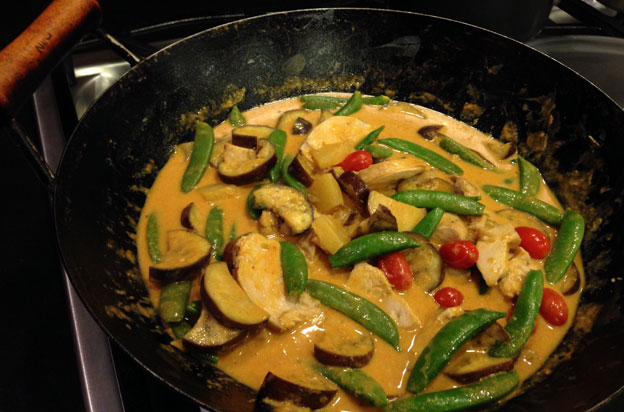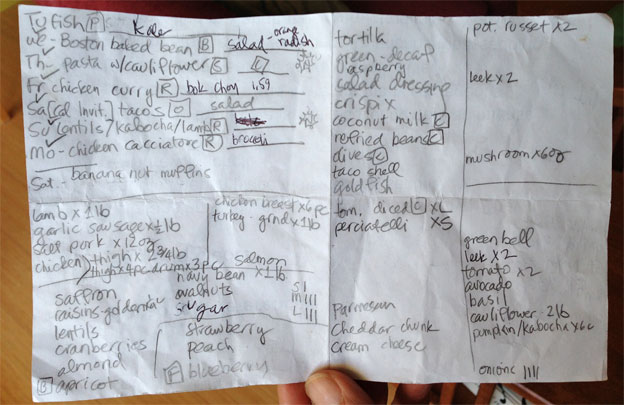In the first part of this series, I listed the 6 steps to making successful resolutions and talked about the first two steps: setting realistic goals and identifying specific behaviors that you have to change or things you have to do to meet those goals. Since we are Cozy Foodies (or aspiring Cozy Foodies), this series is about how to make home-cooking more of a priority in your daily life. But now that you’ve gotten started, how do you stay on track?
Thomas Edison famously said, “genius is 1% inspiration, 99% perspiration.” Staying motivated to make more home-cooked meals is 99% of the work! You can be pretty certain that your breathless excitement and shiny idealism will help you float through the first week or two. But after that, it can be hard to keep up the momentum as life’s demands and dramas wrestle for your attention. Or after investing a meal with your time, energy, and love only to have it scarfed down in between the end of Girls and the next TV show. Here are two ideas to help you along those rocky roads. Hmm, ice cream…. Oh. What was I talking about? Motivation and staying on track. Right. Like I said, it’s not easy, so:
3. Enlist a buddy
Share your resolution with a friend who gives you permission to call her to kvetch, commiserate, or kick you off the couch! As a matter of fact, your buddy should call you regularly to gently check in on whether you are staying on track. Knowing that there is someone out there invested in your success, and that she is going to be calling you about it, can really help keep your resolution as a top priority. In return, cook her a home-cooked meal once in a while, or return the favor by supporting her in her quest, whatever that may be. I have a few friends who I know I can call on for a new idea, to remind me why I love cooking, or to give me permission to slack off for a night.
And I’ve enlisted my very best friend to help, literally! The D.H. is 100% on board with the idea of having home-cooked meals, even if sometimes he thinks I’m more of a Crazy Foodie than a Cozy Foodie. But in addition, he cleans up my messes! That is, he’s in charge of doing the dishes. And lastly, I ask the D.H., very sweetly please, to cook one dinner per week on a weekend night. Since he will just make steaks, Caesar salad, and rice if left to his own devices, I plan what we’ll have for dinner the night he’s cooking (be sure to see tip #1, setting realistic goals!), have the recipes ready to go, and all the ingredients on hand. He’s developed his own “specialties” over time, like homemade pasta with marinara sauce, pizza, tacos, and burgers.
My kids aren’t exactly “buddies,” but they have to help out, too: setting and clearing the table, stirring a pot, fetching an ingredient, and expressing their gratitude for the meal and the work of whoever cooked it (this, by the way, is definitely not a little thing for me). When they have time, I grab them to wash dishes and do prep work. And I ask them for ideas for meals (though I ignore them when they say steak, pizza, and tacos) or feedback on a new dish. In short, they are at least “buddies” in training, and hopefully, aspiring Cozy Foodies themselves!
4. Track your progress
A story I read, “What’s Been for Dinner? She Could Look It Up,” by Susan Dominus in The New York Times (July 12, 2010) made a huge impression on me. The story featured Jenny Rosenstrach, who had kept a dinner diary since 1998. She said:
Sometimes as a mother, you can spend a whole day running around dealing with these little things that are intangible, and you feel like you have nothing to show for it. Dinner is something tangible. So I focus on that.
This struck me as a bone-deep truth, whether as a mother or just another Jane Doe trying to make a positive contribution to society. I was inspired to start a dinner diary of my own and have kept it up ever since. I didn’t want my dinner diary to become a burden, so I just write down what I made or had, with an additional note if it’s a new dish and the main ingredient. I can look things up and jog my memory about what I’ve done in the past. It’s become one more tool that I turn to when I’m planning my menu for the week. And as the entries have multiplied over the years, I feel the accomplishment of what I’ve achieved. It’s a great feeling! So find a way to track your progress, whether it’s keeping a paper-and-pen diary, a blog, or putting stickers or check marks on a calendar; you, too, will feel that sense of success! By the way, since I first read that article, Jenny Rosenstrach started a popular blog and published a book based on her blog, Dinner A Love Story.
There’s another side to tracking your progress. Being able to easily keep track of recipes that work for you and your family is vital to low-fuss planning. My dinner diary is not the only way for me to recall what recipes I’ve used and loved. I also keep a file of tried-and-true recipes that I turn to every week when I’m making my menu plan. Full disclosure: my “file” is a… how should I put this?… it’s a work in progress. I’ve got indexes of recipes on four different spreadsheets, an online recipe box, and never mind all the recipes that I’ve tried from different websites and shelves of cookbooks! I could be more efficient if I spent my life organizing everything, but this hodge-podge system gets the job done. And to be honest, for me, getting all my recipes completely organized is like doing the laundry or making the beds: I know that I’m just going to have to do it all over again, so it never quite gets completely done.
And when life periodically goes into hyper-mega-nuclear-I-am-so-over-this-drive, I have a short list of family favorites to fall back on. These are dinners that I know everyone in my family loves, and more importantly, I can plan them and make them while juggling seventeen deadlines, falling over from a 1,000° fever, and still have enough mental space to sulk about how unfair life is.
Finally, despite all the resolving, planning, prioritizing, and best intentions that you’ve done using tips #1-4, life has a way of happening. That’s when you need tip #5, recognizing that a stumble is not a fall. That’s as important as tip #6, remembering to give yourself rewards along the way. I’ll talk more about these last two steps to making home-cooking a higher priority, in part 3 of this series.
Meanwhile, I’d love to hear your ideas for tracking your progress!





